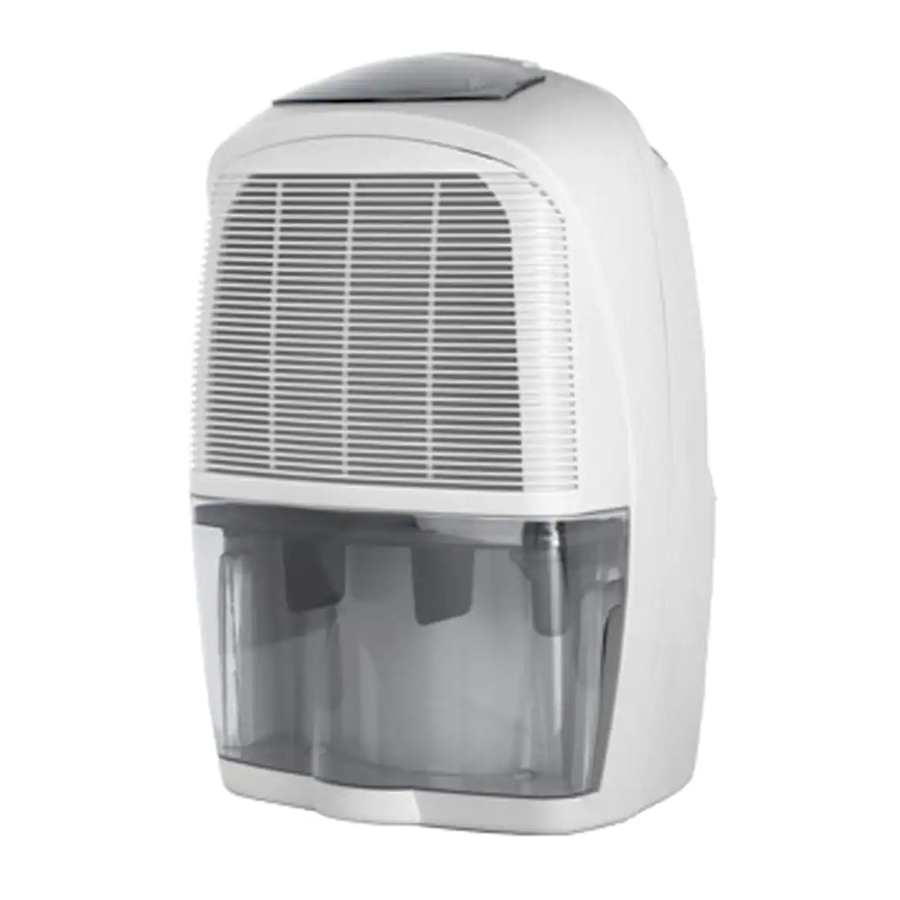
Advertisement
Quick Links
A
ir always contains a certain amount of water in the air in the form of water vapour.
This amount of moisture is commonly known as the humidity.
The capacity of the air to hold water vapour increases with the temperature. This is why in our
homes, as soon as the temperature decreases, the vapour contained in the air condenses, as
is evident on the colder surfaces in the room, such as the windows, walls etc.
The purpose of a dehumidifier is to remove the excess moisture from the air, to control con-
densation within the home.
Experts have established that the optimum environmental conditions for our well being and
preserve objects are obtained between 40% and 60% relative humidity. Below these levels the
air can feel too dry and may cause skin complaints and even static electric shocks.
If temperatures in the home are lower than 10°C for prolonged periods low level heating will
be necessary to allow the condensate to evaporate into the air before dehumidification can
take place. The air will however be slightly warmed by the dehumidifier as the dry air leaving
the dehumidifier is about 1°C higher than normal room temperature.
IMPORTANT INFORMATION FOR CORRECT DISPOSAL OF THE PRODUCT IN ACCORDANCE
WITH EC DIRECTIVE 2002/96/EC.
At the end of its working life, the product must not be disposed of as urban waste.
It must be taken to a special local authority differentiated waste collection centre or to a dealer pro-
viding this service.
Disposing of a household appliance separately avoids possible negative consequences for the
environment and health deriving from inappropriate disposal and enables the constituent mate-
rials to be recovered to obtain significant savings in energy and resources.As a reminder of the
need to dispose of household appliances separately, the product is marked with a crossed-out
wheeled dustbin.
12
I m p o r t a n t
Advertisement

Summarization of Contents
Appliance Description and Accessories
Appliance Components
Identifies and describes key components like control panel, grilles, tank, and handle.
Included Accessories
Lists accessories such as condensate drain hose and rubber bung.
General Safety and Usage Guidelines
Safety Precautions
Covers safe operation, modifications, repairs, adult usage, earthing, and cable handling.
Usage and Installation Restrictions
Details forbidden locations, use on inclines, flammables proximity, and product handling.
Maintenance and Transport Tips
Covers cleaning, filter maintenance, transport, and refrigerant handling.
Electrical Connection Safety
Pre-Connection Checks
Ensures power supply, socket adequacy, plug compatibility, and proper earthing.
Appliance Installation Guide
Fitting the Wheels
Step-by-step instructions for attaching the wheels to the appliance base.
Positioning the Appliance
Specifies required clearance around the unit for proper air circulation.
Condensate Draining Methods
Explains two methods: draining into the tank or continuous external draining.
Dehumidifying with Humidistat Control
Operating the Humidistat Knob
Details adjusting humidity levels using the MIN/MED/MAX settings.
Dehumidifying with Humidistat and Function Knob
Selecting Functions and Humidity
Covers choosing modes like ECON/DRY and setting humidity levels.
Appliance Operating Functions
Air Purification Function
Explains using the electrostatic filter for air cleaning without dehumidifying.
Low Consumption Dehumidification (ECON)
Describes the energy-saving mode that stops when set humidity is met.
Comfort Function
Details the mode for reaching desired comfort levels quickly.
Dry Function (Clothes Drying)
Explains high-capacity mode for rapid moisture removal and drying clothes.
Tank Control System
Tank Indicator Lights
Describes red light warnings for tank status (full, missing, wrong position) and drain issues.
Dehumidification Indicator Lights
Dehumidification Light
Indicates when the machine is actively dehumidifying the room.
Standby and Low Temperature Operation Light
Signals start-up delay or activation of low-temperature operation mode.
Maintenance Procedures
Cleaning the Cabinet
Instructions for cleaning the exterior using a damp cloth, avoiding chemicals.
Cleaning the Air Filter
Steps for removing, cleaning (vacuum or washing), and drying the air filter.
Storage and Filter Replacement
Guidelines for long-term storage and replacing electrostatic filters.
Troubleshooting Common Issues
Appliance Not Working (Indicator Light Off)
Addresses issues like no power, incorrect settings, or tank problems.
Humidity Not Reduced (Light On)
Explains causes like clogged filters, low temperature, or room conditions.
Delayed Start-up
Explains the 3-minute delay due to the appliance's security system.
Technical Characteristics
Appliance Specifications and Limits
Details voltage, power, dimensions, tank capacity, and operating temperature/humidity ranges.






Need help?
Do you have a question about the DEC18 and is the answer not in the manual?
Questions and answers